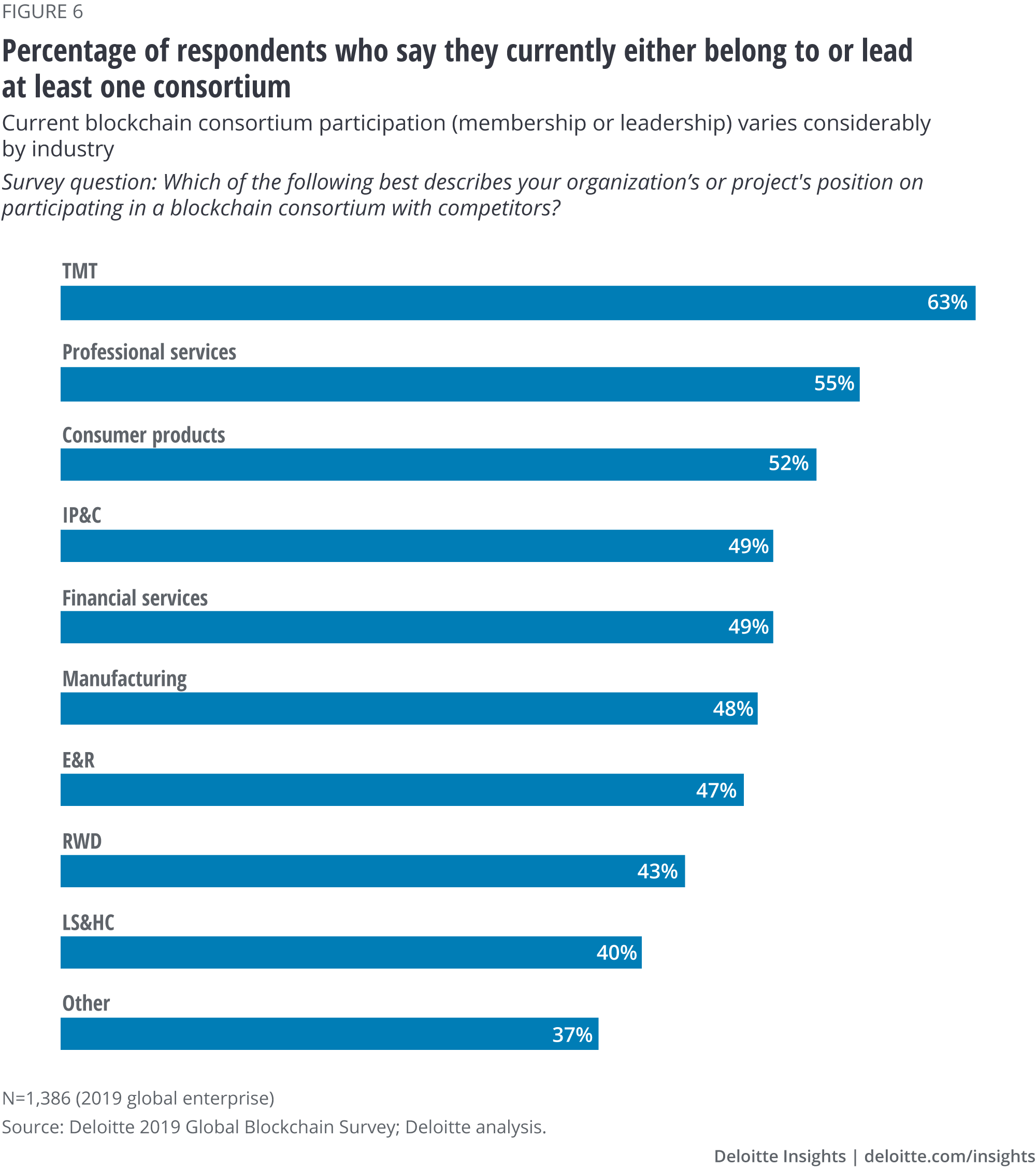
Many paths lead to blockchain adoption, and no two are alike An industry-by-industry look at Deloitte’s 2019 Global Blockchain Survey
22 minute read
28 October 2019
Leaders across a wide range of industries are firmly grasping blockchain's transformative potential. But each industry is finding its own way to leverage the technology to create long-term value.
Introduction
Every disruptive technology first makes an impact somewhere—often with just one so-called lighthouse industry that stands at the leading edge of adoption. A particular group of companies and customers grasp that technology’s long-term value and the ways it might upend current thinking. Aerospace companies, for example, envisioned early on 3D printing’s long-term potential far beyond prototyping and low-volume, “low-risk” spare parts.1 Industrial manufacturers envisioned the potential of robotic technologies in transforming widescale automation processes.2 Over time, organizations from a wider array of industries came to see the potential of these and other disruptive technologies as they found more practical and diverse mainstream applications. Some term this process of industrial adoption the diffusion of innovations.3
Learn more
Read the 2019 Global Blockchain Survey
Download the Deloitte Insights and Dow Jones app
Subscribe to receive more related content
As Deloitte’s 2019 Global Blockchain Survey illustrates, blockchain is going through a similar path of diffusion across industries far beyond its initial fintech applications.4 More organizations in more sectors—such as technology, media, telecommunications, life sciences and health care, and government—are expanding and diversifying their blockchain initiatives. Indeed, as our report makes clear, blockchain appears to be entering a new era of wider, more practical adoption as even many of the reluctant begin to grasp the technology’s long-term potential.
With leaders across industries looking at potential applications, many may wonder: How are different industries adopting and leveraging blockchain technology? Why might companies in one industry—but not others—be highly concerned about a particular kind of barrier to adoption? What is holding back certain industries from greater investment? Do blockchain attitudes and investments vary by industry because of something inherent about the technology? Or is it something about different industries’ individual cultures?
What we discuss in our main survey article speaks to truths at a high level. Yet much can be learned when the level of analysis takes place at a deeper, industrial level. To that end, what we can infer from differences in the ways that individual industries have viewed and adopted blockchain thus far may tell much about what we should expect as blockchain enters its next chapter of mainstream adoption.
In this article, we take a look at the data from our 2019 survey through an industrial lens. While taking a 30,000-feet perspective, we will also examine individual industries in more specific detail. We hope that the reader will come away with the sense that where industrial adoption of blockchain is concerned, there is no single template to follow and one size most assuredly does not fit all.
Overview and methodology statement
Deloitte conducted a survey between February 8 and March 4, 2019, primarily as a research vehicle to gain greater insights into overall attitudes and perceptions toward and investments in blockchain as a technology, including the technology’s potential future impact.
The survey polled a sample of 1,386 senior executives in a dozen locations (Brazil, Canada, China, Germany, Hong Kong, Israel, Luxembourg, Singapore, Switzerland, United Arab Emirates, the United Kingdom, and the United States) at companies with US$500 million or more in annual revenue for US respondents and at companies with US$100 million or more in annual revenue for respondents elsewhere. Respondents had at least a broad understanding of blockchain and were familiar with and able to comment on their organizations’ investment plans. We published our analysis of the survey results on May 6, 2019.5
In this article, we organize our analysis of the survey data through an industry lens. In so doing we identify 10 industrial groupings: consumer products; energy and resources (ER&I); financial services; industrial products and construction (IP&C); life sciences and health care (LS&HC); manufacturing; professional services; retail, wholesale and distribution (RW&D); technology, media, and telecommunications (TM&T); and “other.” The last category ("other") includes automotive; travel, hospitality & services; higher education (private); government & public services; agricultural products & food processing; and aerospace & defense.
A high-level perspective: How industries are investing in blockchain
More than anything, the 2019 blockchain survey revealed the emerging shared belief that blockchain is real—and that it can serve as a pragmatic solution to business problems across industries and use cases. Even leaders initially wary of tech-based solutions appear to see potential in the technology. Specific supporting indications from our survey include the increasing perception of blockchain as a top-five strategic priority, the sustained levels of blockchain investment, and the improved sentiments measured across an array of attitude statements, including the share of respondents who agree that blockchain offers compelling use cases. We found additional signs of blockchain’s maturation in the diverse—and sometimes discordant—responses, reflecting leading kinds of use cases, the wider array and near parity of barriers to blockchain adoption, perceived advantages of blockchain, and regulatory concerns. Such diversity of thought can be viewed as a mark of maturation because it reflects an enhanced sense of seriousness in consideration of the technology’s possibilities and limitations.
As we suggested then, the prevailing question among executives is no longer, “Will the technology work?” but rather, “How can we make technology work for us?” But it is just as true that how executives make blockchain work for them is informed by the characteristics of the industries within which they operate. After all, each industry is uniquely defined by individual operational, regulatory, and even cultural characteristics that, collectively, help shape the speed and manner with which it adopts disruptive technologies.
How executives make blockchain work for them is informed by the characteristics of the industries within which they operate.
It may therefore be useful to take a comparative look at a number of metrics through the prism of the individual industries that comprise our pool of survey respondents. In so doing, we start with facts on the ground—actual investment dollars that organizations are making or shortly expect to make in blockchain initiatives. In our global survey, some 40 percent of overall respondents say their companies plan to invest US$5 million or more in blockchain initiatives in the next 12 months, consistent with future investment plans from our 2018 survey. Figure 1, however, illustrates that degree of commitment varies considerably across industries, with TMT leading the pack at 49 percent, followed by E&R and manufacturing at 43 percent each.6 Figure 1 also compares respondents’ future 12-month blockchain investment plans with actual prior 12-month blockchain investment spending. In nearly every case, planned spending increased or stayed the same relative to actual prior spending as a share of survey respondents—a testament to confidence in the technology’s long-term potential.

Figure 2, somewhat analogously, breaks out existing blockchain production with planned production within a year. TMT leads this metric as well, with some 76 percent of respondents saying that they either have placed blockchain into production or plan to within a year, followed by manufacturing, professional services, and financial services. But figure 2 also shows that, for each industry, substantially more respondents say that they plan to put blockchain into production in the next year than have already done so. For example, 32 percent of TMT respondents say they have put the technology into production, while 44 percent of TMT respondents say they will do so within the next year. This pattern repeats for each industrial grouping in figure 2, sometimes markedly so. We can view this gap as an additional affirmative belief in blockchain’s long-term value.

Figure 3 compares the share of companies within each industry that are currently hiring blockchain talent with the share that plans to within one year. Again, TMT leads in terms of current hiring, followed by manufacturing, LS&HC, and financial services. But when both current and planned hiring are combined, manufacturing respondents take the lead, with financial services and TMT close behind. The positive news is that current and near-term blockchain hiring is relatively strong, with at least 70 percent of respondents in seven of the 10 identified industrial groupings answering affirmatively.

The data from figures 1, 2, and 3 shows that industries are making real hard-dollar investments in blockchain initiatives, and other investment data from our survey—in such areas as use of consultants and developing front- and back-end blockchain solutions—helps complete the picture. Responses suggest a fairly wide distribution in investment activity across industries—for example, our survey reveals that TMT stands out as a consistent leader in blockchain investment, followed by manufacturing and financial services. And while certain industries are more active than others in making hard-dollar bets on blockchain’s long-term potential, each industry grouping is represented among the top five leaders at least once in figures 1, 2, and 3. Such is entirely consistent with the larger theme from the 2019 global survey that blockchain is gaining traction across industries as a plausible—and even practical—solution. It is no longer the exclusive province of a handful of industries.
To further illustrate this point, we see a similar diversity of leadership when we consider attitudes and sentiments about blockchain. Figure 4 shows the top five industrial groupings of respondents for each of six key survey questions concerning blockchain attitudes. While some industries are represented more often than others, each industry is, again, represented at least once among the top five. It is also worth noting that the intensity and consistency of feeling varies from question to question.

And as more industries explore blockchain solutions, they will likely do so in a way that reflects their respective unique operational and strategic needs. Thus, as figure 5 illustrates, top blockchain use cases vary considerably for respondents, however much data validation remains a common choice. Beyond use cases, industries are finding their unique blockchain voices in preferred blockchain platforms, how they measure success in blockchain use cases, regulatory concerns, time frame for return on investment, recruitment approaches, and blockchain architectures (see sidebar, “A few words on consortia”), among other areas.

What all such data from our survey points to is a sorting-out process, as each industry pursues blockchain in a way that best serves its collective interests. Put another way, just as there is no single way that industries will develop blockchain applications, there is no universal approach to industrial blockchain adoption.
A few words on consortia
Coopetition—a willingness to work with your competitors and others in your industrial ecosystem toward some common purpose—may seem counterintuitive. Perhaps it is unsurprising that the share of survey respondents focusing on consortia as a preferred blockchain model lags alternatives such as public and private blockchain architectures. After all, the consortium idea is based on coopetition, and overcoming parochial instincts is seldom easy.7 Indeed, in our global survey, we call it arguably “blockchain’s largest barrier to entry.” But our survey also found that organizations understand the inherent value in such collective undertakings, as more than 90 percent of respondents—including more than 90 percent in each separate industry8—said that they belong to or lead at least one consortium, or plan to join or lead one within a year.
When we consider only current industry participation in consortia, the distribution of respondents by industry classification is much wider, as figure 6 shows. The precise reasons that certain industries appear to have been more pioneering and aggressive in their attitudes toward blockchain consortia than others thus far are likely varied and possibly informed by that industry’s early recognition of blockchain’s potential—or, specifically, of the value that coopetition offers. That the spread is much more compact when we consider both current participation and planned near-term participation suggests the growing recognition of the value that consortia offer, even among those industries that are lagging in their current degree of consortia participation.

What motivates organizations to join—or lead—consortia in the first place? Figure 7 depicts the top two benefits that respondents within each industry expect from consortia participation. While accelerated learning and cost savings predominate among leading benefits, others such as sharing of risks and influencing standards are also leading benefits for some industries. And just as there is a degree of variability in top benefits across industries, there is variability in the intensity with which respondents within each industry chose their respective top benefits. Such variability speaks, again, to the uniqueness of each industry’s blockchain journey.

Industry focus
It is nearly impossible to generalize about industrial adoption of blockchain technology. Indeed, a recurring theme of our analysis is the individual approach that each industry takes in how it views and adopts blockchain technology. Since industries differ in any number of ways, we should not expect any two industries to view blockchain identically in how the technology can advance companies’ respective strategic priorities. Moreover, the conservative ethos of some industries may make them inherently more reluctant to adopt new technologies generally—especially technologies that did not organically emerge from within their own, respective domain of expertise. This may be especially true with respect to blockchain given its early association with cryptocurrency and financial applications, which may have led to initial misunderstandings about the technology’s broad potential.
Regardless of the underlying reasons why each industry’s blockchain journey is unique, it is clear that executives across industries now understand and are exploring more fully the technology’s myriad potential applications. Toward that end, we take a deeper look at a few industries where blockchain has taken particularly strong root.
Financial services
When we discuss the evolution of blockchain applications, what we really are saying is that organizations are discovering new ways that blockchain can work beyond its original purpose as the underlying driver of a new distributed cryptoeconomy. Some may assume, as a result, that blockchain-inspired disruption is all taking place in industries other than financial services. Such a notion is plainly groundless: Years after bitcoin introduced the world to blockchain, the technology continues to change the financial services industry as much as it is changing other industries—and in ways quite distinct from its original crypto-driven applications.
None of this should be surprising, since the very nature of blockchain as a way for interested parties to interact is well suited for financial services, whose lifeblood is multiparty transactional communication. Indeed, over the last few years, firms across the industry have explored blockchain use cases as ways to streamline and facilitate performance in such areas as digital payments, data validation, know-your-customer/anti–money laundering, tokenized assets, asset transfer, trade finance, letters of credit, title protection, and beyond.9
Financial services firms have shown their willingness and ability to adopt new technologies to disrupt the status quo. The quaintness of brick-and-mortar banking and retail brokerage services speaks well to that point.
As these use cases evolve and newer use cases emerge, a shift in mindset should follow from the vision of blockchain as a process efficiency tool to a driver of new business models and revenue streams. In a highly regulated and somewhat conservative industry, that may take time. Other challenges will remain as well, including speed, privacy, and scalability. But financial services firms generally have shown willingness and ability to adopt new technologies to disrupt the status quo. The quaintness of brick-and-mortar banking and retail brokerage services speaks well to that point. There should be little doubt about the industry’s ability to assimilate blockchain technology in all its transformational potential.

Technology, media, and telecommunications
There is no single way in which TMT companies pursue blockchain solutions any more than there is one kind of TMT organization. Indeed, TMT itself is really a collection of sectors, each with a constituency and strategic imperatives. Thus, how any one TMT sector uses blockchain tends to be very situational. Cloud providers are adding blockchain development tools to their platform service offerings to give complete traceability to the cloud. Telecom may look to use blockchain as a way to reduce roaming and other kinds of fraud. Media companies are using blockchain to enforce digital rights and payments to content creators.10
This is just the tip of the iceberg: Our survey results suggest that TMT executives are bullish on blockchain and companies are exploring a wide range of potential applications. TMT respondents lead all industries in prior 12-month investment of at least US$5 million (45 percent) and future 12-month investment of at least US$5 million (49 percent). TMT leads all others in our survey in either having already brought blockchain into production or planning to within 12 months, at 77 percent in combined total. At 56 percent, TMT respondents lead in currently hiring blockchain talent. And respondents show TMT to be a leader in consortium participation (current or planned), those who believe in the scalability of blockchain, and those who perceive the compelling nature of blockchain use cases.
The list goes on. But the larger point is that, as our survey suggests, leaders in every corner of the TMT industry see the potential that blockchain offers in driving value, trust, and transparency.

Life sciences and health care
There may be nowhere that blockchain can have more immediate, consequential impact than in life sciences and health care—an industry in which data transparency, speed of access, immutability, traceability, and trustworthiness are vital in a complex network of pharma researchers, insurers, patients, and care providers. Already, LS&HC players report blockchain’s impact in driving use cases that span the full value spectrum—from clinical collaboration to claim submission and adjudication to longitudinal patient data to informed consent management to patient-reported outcomes, and beyond, as part of a shared blockchain network.11
Indeed, because such a network has so many stakeholders, it is perhaps unsurprising that LS&HC respondents named interoperability as a top challenge in blockchain adoption, with implementation ranking second among greatest barriers to overcome in further adoption. Nor is it surprising for the same reason that these respondents cited data access/sharing as the most preferred blockchain use case. Given the degree of government oversight that often characterizes the industry, regulatory concerns expectedly represent another prominent challenge for LS&HC respondents to overcome in implementing blockchain solutions, especially in such areas as financial reporting/tax and privacy. On the other hand, perhaps because of the vast and eclectic array of industry stakeholders, consortia leadership is substantially above the overall average.
All of this said, the LS&HC industry respondents in our study see great potential, even if progress remains somewhat nascent, in how blockchain might transform how health care is deployed. Large-scale adoption would take time. But LS&HC companies show their commitment through planned investment—especially in blockchain talent—consortia formation, and generally favorable attitudes.

Energy and resources
In the E&R industry, blockchain is largely an evolving idea, as organizations try to figure out where the technology can best be put to use in the overarching E&R value chain. Proofs-of-concept are underway in a wide range of areas: metering, billing, and security; decentralized energy trading; wholesale energy trading; access to wholesale energy markets to end-use customers; green certificates and carbon trading; grid management; IoT-based asset management; and e-mobility.12 At this point, these projects tend to be low-scale and toward the downstream end of the value chain, which may be somewhat counterintuitive, since upstream processes tend to be more protracted and could benefit from the increased efficiencies and speed that blockchain may provide. Yet upstream E&R operations are also considerably more capital-intensive than activities closer to the customer, and concerns about blockchain’s ease of integration with legacy systems may make the technology a tougher sell for oil and gas exploration executives.
And our survey suggests that blockchain does face challenges in achieving wider adoption within E&R. Leaders who participated in our survey identified security and talent as two key obstacles and also cited as challenges scalability, speed, cost of development, and regulatory concerns in a highly regulated industry. Moreover, our survey points to additional signs that E&R blockchain adoption is still an uphill climb. E&R respondents say that only 34 percent of their executive teams strongly believe that there is a compelling use case for blockchain, compared to 47 percent overall. Only 40 percent strongly believe blockchain will enable new business models and revenue streams, versus 52 percent for overall survey respondents. Those E&R respondents who view blockchain as a top-five priority and are currently hiring blockchain talent also lag overall respondents, especially curious given that respondents cite blockchain talent as a key obstacle to wider adoption. Though many believe that smart contracts could play a big role in driving blockchain adoption in as highly transactional an industry as E&R, only 47 percent of industry survey respondents see smart contracts as highly important—well below the 58 percent of overall respondents and second-lowest among our industrial groupings. Finally, only 12 percent of E&R respondents say their companies have already brought blockchain into production, far behind overall respondents and the lowest ranking among our industrial groupings.
Still, if blockchain is to truly disrupt some parts of the E&R value stream, there appear to be some signs of optimism to think that such a day is not far off. For one thing, as mentioned, a number of pilot projects are in development. And, in fact, leading industry players are driving blockchain consortia activity, perhaps in an effort to spark greater adoption throughout E&R.13 Moreover, our survey states that about one-third of E&R respondents strongly agree that blockchain will disrupt their industry, meaningfully more than average and second only to industrial products and construction. Within the subsector of power and utilities, that percentage rises to 41 percent, consistent with where the bulk of pilot project activity appears to be currently. In addition, some 43 percent of E&R respondents say they plan to invest at least US$5 million in blockchain activities in the next 12 months, slightly above the survey average.
If blockchain is to truly disrupt some parts of the energy and resources value stream, there appear to be some signs of optimism to think that such a day is not far off.
At the end of the day, however, blockchain has yet to make any kind of truly manifest impact within E&R, at least not in comparison to other industries. But how blockchain affects industries can unfold rapidly. And this industry offers opportunities for disruption that align neatly with the kinds of transformational change that only a technology such as blockchain can provide. What a difference a year may make. Stay tuned.

Manufacturing
The supply chain is at the heart of every manufacturing organization; it is the channel through which information, materials, services, and financial resources flow from idea to end-use delivery in a life cycle of value-added transactions. And even in a world of digital supply networks, supply chain processes are susceptible to a host of vulnerabilities and pain points:
- Traceability, the ability to monitor events within a digital supply network at any given point in time
- Compliance, the application of control mechanisms to ensure that regulatory protocols are satisfied
- Flexibility, responding to changing events quickly with minimal downtime or substantially increased costs
- Stakeholder management, the established and enforced rules of governance to drive communication and mitigate risk
Blockchain capabilities may help relieve these supply chain pain points. For example, the auditability that blockchain offers may allay concerns about traceability. Blockchain would make compliance issues less of a concern given the immutability of all transactions as a “single source of truth.” Smart contracts—at the core of many blockchain architectures—can provide supply chain organizations situational flexibility. And disintermediation that blockchain offers can help facilitate stakeholder managers in allowing trusted peer-to-peer transactions.14
While blockchain is hardly a panacea for all that may ail a supply chain organization, an abundance of faith in blockchain’s potential finds expression in a wide host of use cases that range from tracking and tracing to purchasing platforms to stakeholder verification (“know your supplier”) to supply chain cybersecurity to counterfeit prevention to warranty management, and well beyond. Given this, it follows that 65 percent of manufacturing respondents to our survey say that blockchain is a top-five priority—the highest among all our industrial groupings. In a similar regard, given what smart contracts can do to alleviate supply chain flexibility concerns, 63 percent of manufacturing respondents say that smart contracts are highly important, second only to TMT.
Finally, a manufacturing supply chain, perhaps because of its multiple-stakeholder orientation, could benefit from the development of consortia to address technical, regulatory, or other challenges in common. A bit over one-third (34 percent) of manufacturing respondents said that they have led or plan to lead consortia, compared to 25 percent overall.15
Supply chains continue to undergo innovation, transformation, and improvement—all made possible by the adoption of transformational technologies. Toward that end, blockchain has the potential to play a prominent role in accelerating these changes.

Government as blockchain user—and regulator
Government plays the uniquely dual role of regulator and user of blockchain. As a general matter, blockchain-related regulatory attention has focused on cryptocurrencies, with regulators helping to shape their legal status as they evolve.16 More recently, regulatory concerns about blockchain have gained traction outside of digital assets. For example, the General Data Protection Regulation (GDPR) places strict limitations on how personal data is stored and saved within the European Union. Some see the GDPR leading to an unavoidable clash with the intrinsic immutability of how data is stored on blockchain platforms.17 Similarly, in the United States, the Health Insurance Portability and Accountability Act (HIPAA) limits how personal health information is handled, which may run afoul of blockchain-based solutions within the life sciences context.18 Indeed, our government survey respondents cited privacy more than any other area of regulatory concern (50 percent). So it seems apparent that these and other privacy-based regulations could need to align with the evolving technology.
Moreover, though technically not a governmental entity, the International Organization for Standards is creating a global framework for blockchain focusing on key areas such as architecture, taxonomy, and ontology.19 In the United States, at least one state has passed regulations on the legal status of blockchain companies as limited liability companies; others have passed laws on the enforceability of blockchain-based transactions.20 Additional regulatory developments are anticipated in other blockchain applications, such as supply chain tracking, voting records, and general information reporting.
At the same time, governments do more than merely regulate blockchain technology—they often advocate for and incubate new blockchain applications. Over the past several years, we have observed government blockchain participation that extends beyond education and tentative experimentation—specifically, moves toward tactical, bold plays that drive innovation. Representative public use cases include: digital currency/payments (Canada, Singapore, United Arab Emirates, Saudi Arabia); land rights (United States, Brazil, Sweden); voting in elections (United States, Australia, Japan, South Korea); shareholder proxies (United Arab Emirates); identity management (Switzerland, Estonia, United Arab Emirates, Singapore); health care (United States, Estonia); and defense/security (United States).21
Concluding thoughts
It bears repeating. The story of blockchain industrial adoption appears to echo the plot of industrial adoption of other disruptive technologies: An industry forays into what is possible; others join and help shape what is plausible; still others give form and texture into what emerges as practical. Within the context of blockchain, that narrative is well underway. It is also a story that each industry is shaping into its own narrative, without template, in a way that suits its individual qualities and needs.
Such is the versatile character of blockchain that each industry—indeed, each organization within each industry—explores what works for it. As we have said, this process of serious self-discovery collectively finds expression in the wide variety of use cases, attitudes, concerns, and perceived obstacles across industries. But it also finds expression in that any given industry may harbor views and practices with respect to one blockchain-related issue that seem at odds with that industry’s views and practices on another issue. All of this seeming incoherence is really the sum and substance of this evolutionary process as each industry sorts out the most sensible path to blockchain adoption.
Certainly, we cannot predict with any degree of precision what the future holds for any given industry as its blockchain story unfolds. But if past is prologue, and it often is, we can say the journey is far from over. Blockchain in 2019 is now too plausible, too practical, too serious, too real to fall away as just another interesting yet unproven technology. We see it in the data. We hear it from our clients.
This is where things get really interesting. Let the story continue.
Appendix






© 2021. See Terms of Use for more information.
Explore more on Blockchain
-
Will blockchain transform the public sector? Article7 years ago
-
How telecom, media, and entertainment can find value in blockchain Article6 years ago
-
Powered by blockchain Article6 years ago
-
Banding together for blockchain Article7 years ago
-
Blockchain to blockchains Article7 years ago
-
3D opportunity for blockchain Article8 years ago




















